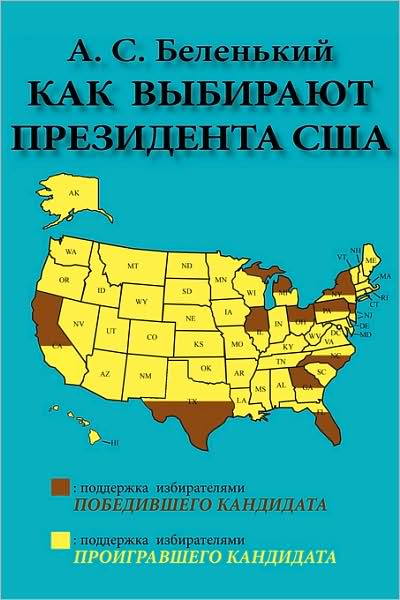
Tell your friends about this item:
How a President of the United States is Elected: (In Questions and Answers) (Russian Edition) Russian edition
Alexander S. Belenky
How a President of the United States is Elected: (In Questions and Answers) (Russian Edition) Russian edition
Alexander S. Belenky
This is the first book in Russian that describes the system of electing a U. S. President. Look at the following statements concerning U. S. Presidential elections: 1. The system of electing a U. S. President (the election system) was never designed to service the popular will. 2. The currently existing election system does not follow some major ideas of the Founding Fathers. 3. Certain election rules are such that if they were to be applied, an intervention of the U. S. Supreme Court in the election being in progress would be almost inevitable. 4. Amendment 12 of the U. S. Constitution contains at least six puzzles relevant to U. S. Presidential elections with answers that have remained unknown for more than 200 years. 5. The text of the U. S. Constitution contains a mathematically incorrect clause. 6. Skillfully using the election system may allow a U. S. Presidential candidate to win the U. S Presidency with, for instance, less than 30% of the nationwide popular vote. 7. The application of some of the election rules can lead to a constitutional crisis in the country. 8. When Americans cast their votes in U. S. Presidential elections, they do not vote for President or for Vice President, despite what they may see on the ballots or on the voting machines. 9. The "winner-take-all" principle does not encourage U. S. Presidential candidates to fight for each and every vote in a state or in DC. 10. Many statements about the Electoral College mechanism aimed at substantiating its presence in the election system, including those in the government publications, are no more than myths of their authors, no matter how plausible these myths may seem. 11. An electoral tie in the Electoral College may be resolved not necessarily in favor of a person voted for as President who has support from at least 26 delegations in the House of Representatives. 12. There is no need to abolish the Electoral College mechanism in order
| Media | Books Paperback Book (Book with soft cover and glued back) |
| Released | April 14, 2008 |
| ISBN13 | 9781434354679 |
| Publishers | AuthorHouse |
| Pages | 168 |
| Dimensions | 11 × 152 × 229 mm · 254 g |
| Language | English Russian |
More by Alexander S. Belenky
See all of Alexander S. Belenky ( e.g. Paperback Book and Hardcover Book )



![Cover for Alexander S. Belenky · Who Will Be the Next President?: A Guide to the U.S. Presidential Election System (Paperback Book) [Softcover reprint of the original 2nd ed. 2016 edition] (2018)](https://imusic.b-cdn.net/images/item/original/121/9783319831121.jpg?alexander-s-belenky-2018-who-will-be-the-next-president-a-guide-to-the-u-s-presidential-election-system-paperback-book&class=scaled&v=1610342801)
![Cover for Alexander S. Belenky · Who Will Be the Next President?: A Guide to the U.S. Presidential Election System (Hardcover Book) [2nd ed. 2016 edition] (2016)](https://imusic.b-cdn.net/images/item/original/950/9783319446950.jpg?alexander-s-belenky-2016-who-will-be-the-next-president-a-guide-to-the-u-s-presidential-election-system-hardcover-book&class=scaled&v=1487427407)
![Cover for Alexander S. Belenky · Understanding the Fundamentals of the U.S. Presidential Election System (Paperback Book) [2012 edition] (2014)](https://imusic.b-cdn.net/images/item/original/062/9783642436062.jpg?alexander-s-belenky-2014-understanding-the-fundamentals-of-the-u-s-presidential-election-system-paperback-book&class=scaled&v=1408499723)

![Cover for Alexander S. Belenky · Operations Research in Transportation Systems - Applied Optimization (Paperback Book) [1st Ed. Softcover of Orig. Ed. 1998 edition] (2010)](https://imusic.b-cdn.net/images/item/original/038/9781441948038.jpg?alexander-s-belenky-2010-operations-research-in-transportation-systems-applied-optimization-paperback-book&class=scaled&v=1530908119)


